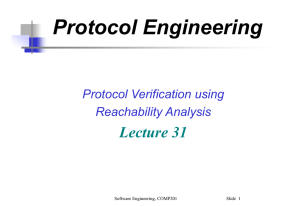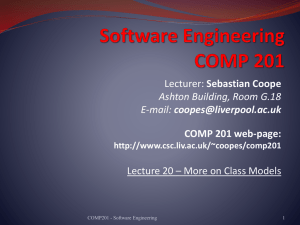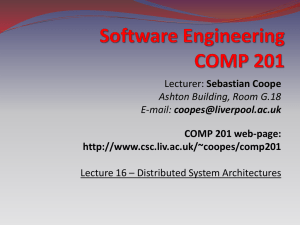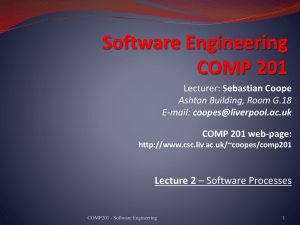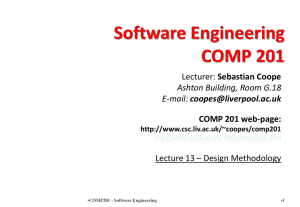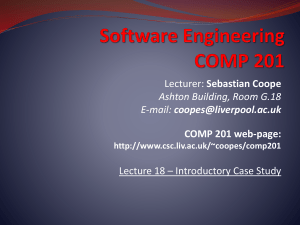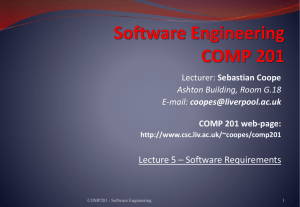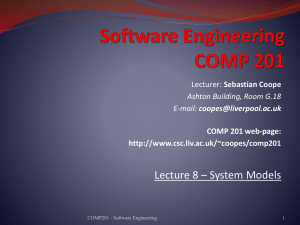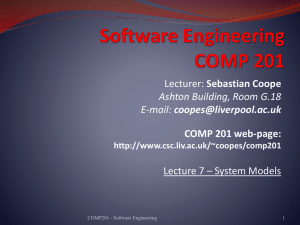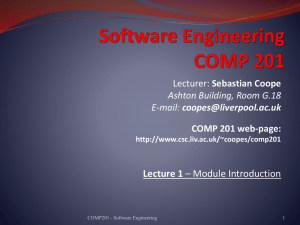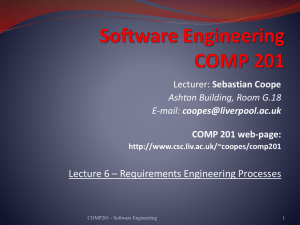SE_L15
advertisement
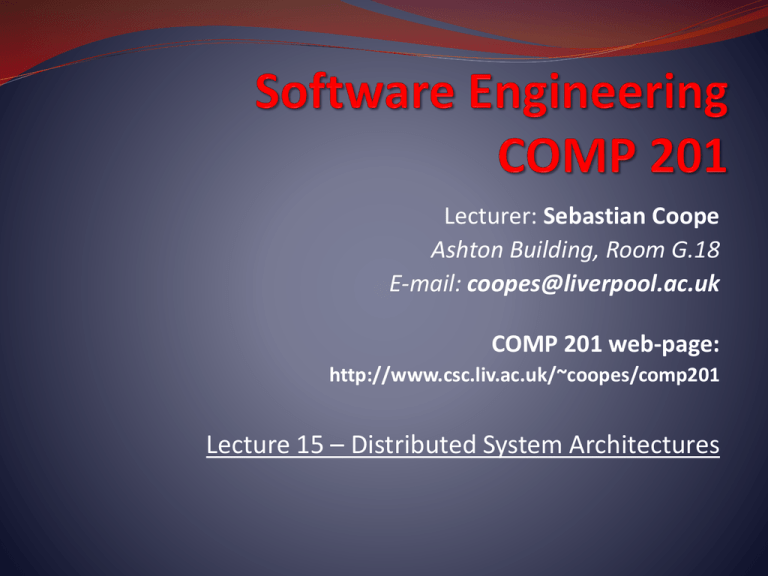
Lecturer: Sebastian Coope Ashton Building, Room G.18 E-mail: coopes@liverpool.ac.uk COMP 201 web-page: http://www.csc.liv.ac.uk/~coopes/comp201 Lecture 15 – Distributed System Architectures Architectural Design - Establishing the Overall Structure of a Software System Topics covered: System structuring Control models Modular decomposition Multiprocessor architectures Client-server architectures Distributed object architectures COMP201 - Software Engineering Architectural Design Distributed Systems Architectures 2 Software Architecture The design process for identifying the sub-systems making up a system and the framework for sub-system control and communication is architectural design The output of this design process is a description of the software architecture COMP201 - Software Engineering 3 Architectural Design Architectural design should be an early stage of the system design process Represents the link between specification and design processes Often carried out in parallel with some specification activities It involves identifying major system components and their communications COMP201 - Software Engineering 4 Architectural Design Process System structuring The system is decomposed into several principal subsystems and communications between these sub-systems are identified Control modelling A model of the control relationships between the different parts of the system is established Modular decomposition The identified sub-systems are decomposed into modules COMP201 - Software Engineering 5 Sub-systems and Modules A sub-system is a system in its own right whose operation is independent of the services provided by other subsystems. A module is a system component that provides services to other components but would not normally be considered as a separate system COMP201 - Software Engineering 6 Real world Sub-system examples Typically organized as Java packages/C++ libraries/C# assemblies Database access layer MySQL access, JDBC layer Security services Encryption classes, signature classes (modules) External Payment sub-system Email service sub-system Logging sub-system Financial transaction sub-system Marketing sub-system COMP201 - Software Engineering 7 Architectural Models Different architectural models may be produced during the design process Each model presents different perspectives on the architecture: Static structural model Dynamic process model Interface model Relationships model COMP201 - Software Engineering 8 Architectural Models Static structural models show the major system components Dynamic process models show the process structure of the system Interface models define sub-system interfaces Relationships models such as a data-flow model COMP201 - Software Engineering 9 System Structuring Concerned with decomposing the system into interacting sub-systems The architectural design is normally expressed as a block diagram presenting an overview of the system structure (More specific models showing how sub-systems share data, are distributed and interface with each other may also be developed) COMP201 - Software Engineering 10 Packing Robot Control System Vision system Object identification system Arm controller Gripper controller Packaging selection system Packing system COMP201 - Software Engineering Conveyor controller 11 The Repository Model Sub-systems must exchange data. This may be done in two ways: Shared data is held in a central database or repository and may be accessed by all sub-systems Each sub-system maintains its own database and passes data explicitly to other sub-systems When large amounts of data are to be shared, the repository model of sharing is most commonly used COMP201 - Software Engineering 12 Client-Server Architecture Distributed system model which shows how data and processing is distributed across a range of components: Set of stand-alone servers which provide specific services such as printing, data management, etc. Set of clients which call on these services Network which allows clients to access servers COMP201 - Software Engineering 13 Film and Picture Library Client 1 Client 2 Client 3 Client 4 Wide-bandwidth network Catalogue server Video server Picture server Hypertext server Catalogue Film clip files Digitiz ed photographs Hypertext web COMP201 - Software Engineering 14 Client-Server Characteristics Advantages Distribution of data is straightforward Makes effective use of networked systems. May require cheaper hardware Easy to add new servers or upgrade existing servers Disadvantages No shared data model so sub-systems use different data organisation. data interchange may be inefficient Redundant management in each server No central register of names and services - it may be hard to find out what servers and services are available COMP201 - Software Engineering 15 Abstract Machine Model - Used to model the interfacing of sub-systems Organises the system into a set of layers (or abstract machines) each of which provide a set of services Supports the incremental development of sub-systems in different layers. When a layer interface changes, only the adjacent layer is affected However, it is often difficult to structure systems in this way COMP201 - Software Engineering 16 ISO/OSI Network Model 7 Application Application Application 6 Presentation Presentation 5 Session Session 4 Transport Transport 3 Network Network Network 2 Data link Data link Data link 1 Physical Physical Physical Communica tions medium COMP201 - Software Engineering 17 Control Models Control Models are concerned with the control flow between sub systems: Centralised control One sub-system has overall responsibility for control and starts and stops other sub-systems Event-based control Each sub-system can respond to externally generated events from other sub-systems or the system’s environment COMP201 - Software Engineering 18 Centralised Control A control sub-system takes responsibility for managing the execution of other sub-systems. There are two main types of centralised control models (sequential or parallel): Firstly, there is the call-return model Top-down subroutine model where control starts at the top of a subroutine hierarchy and moves downwards. Applicable to sequential systems Such a model is embedded into familiar programming languages such as C, Java, Pascal etc. COMP201 - Software Engineering 19 Call-Return Model Main program Routine 1 Routine 1.1 Routine 2 Routine 1.2 COMP201 - Software Engineering Routine 3 Routine 3.1 Routine 3.2 20 Centralised Control If the controlled subsystems run in parallel, then we may use the manager model of centralised control: Manager model Applicable to concurrent systems. One system component controls the stopping, starting and coordination of other system processes. Can also be implemented in sequential systems as a case statement. COMP201 - Software Engineering 21 Real-Time System Control Sensor processes Actuator processes System contr oller Computation processes User interface COMP201 - Software Engineering Fault handler 22 Event-Driven Systems Driven by externally generated events where the timing of the event is out of the control of the sub-systems which process the event There are two principal event-driven models: Broadcast models. An event is broadcast to all sub-systems. Any sub-system which can handle the event may do so Interrupt-driven models. Used in real-time systems where interrupts are detected by an interrupt handler and passed to some other component for processing COMP201 - Software Engineering 23 Broadcast Model Effective in integrating sub-systems on different computers in a network Sub-systems register an interest in specific events. When these occur, control is transferred to the subsystem which can handle the event Control policy is not embedded in the event and message handler. Sub-systems decide on events of interest to them However, sub-systems don’t know if or when an event will be handled COMP201 - Software Engineering 24 Selective Broadcasting Sub-system 1 Sub-system 2 Sub-system 3 Sub-system 4 Event and messa ge handler COMP201 - Software Engineering 25 Interrupt-Driven Systems Used in real-time systems where fast response to an event is essential There are known interrupt types with a handler defined for each type Each type is associated with a memory location and a hardware switch causes transfer to its handler Allows fast response but complex to program and difficult to validate COMP201 - Software Engineering 26 Interrupt-Driven Control Interrupts Interrupt vector Handler 1 Handler 2 Handler 3 Handler 4 Process 1 Process 2 Process 3 Process 4 COMP201 - Software Engineering 27 Modular Decomposition Another structural level where sub-systems are decomposed into modules Two modular decomposition models covered An object model where the system is decomposed into interacting objects A data-flow model where the system is decomposed into functional modules which transform inputs to outputs. Also known as the pipeline model If possible, decisions about concurrency should be delayed until modules are implemented COMP201 - Software Engineering 28 Object Models Structure the system into a set of loosely coupled objects with well-defined interfaces Object-oriented decomposition is concerned with identifying object classes, their attributes and operations When implemented, objects are created from these classes and some control model used to coordinate object operations COMP201 - Software Engineering 29 Invoice Processing System Customer Receipt customer# name address credit period Invoice invoice# date amount customer Payment invoice# date amount customer# issue () sendR eminder () acceptPayment () sendR eceipt () invoice# date amount customer# COMP201 - Software Engineering 30 Data-Flow Models Functional transformations process their inputs to produce outputs May be referred to as a pipe and filter model (as in UNIX shell) Variants of this approach are very common. When transformations are sequential, this is a batch sequential model which is extensively used in data processing systems Not really suitable for interactive systems COMP201 - Software Engineering 31 Invoice Processing System Read issued invoices Invoices Issue receipts Receipts Find payments due Issue payment reminder Identify payments Reminders Payments COMP201 - Software Engineering 32
